
The Municipality and Borough of Skagway is a first-class borough in Alaska on the Alaska Panhandle. As of the 2020 census, the population was 1,240, up from 968 in 2010. The population doubles in the summer tourist season in order to deal with more than 1,000,000 visitors each year. Incorporated as a borough on June 25, 2007, it was previously a city in the Skagway-Yakutat-Angoon Census Area. The most populated community is the census-designated place of Skagway.

The Klondike Gold Rush was a migration by an estimated 100,000 prospectors to the Klondike region of Yukon, in north-western Canada, between 1896 and 1899. Gold was discovered there by local miners on August 16, 1896; when news reached Seattle and San Francisco the following year, it triggered a stampede of prospectors. Some became wealthy, but the majority went in vain. It has been immortalized in films, literature, and photographs.

The Chilkoot Trail is a 33-mile (53 km) trail through the Coast Mountains that leads from Dyea, Alaska, in the United States, to Bennett, British Columbia, in Canada. It was a major access route from the coast to Yukon goldfields in the late 1890s. The trail became obsolete in 1899 when a railway was built from Dyea's neighbor port Skagway along the parallel White Pass trail.

Chilkoot Pass is a high mountain pass through the Boundary Ranges of the Coast Mountains in the U.S. state of Alaska and British Columbia, Canada. It is the highest point along the Chilkoot Trail that leads from Dyea, Alaska to Bennett Lake, British Columbia. The Chilkoot Trail was long a route used by the Tlingit for trade.

Bennett Lake is a lake in the Province of British Columbia and Yukon Territory in northwestern Canada, at an elevation of 2602 ft.. It is just north of the border with the United States state of Alaska, near the Alaskan port of Skagway.
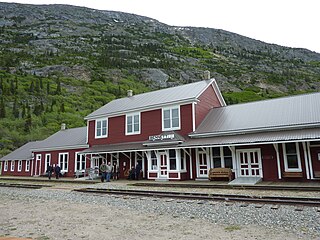
Bennett, British Columbia, Canada, is an abandoned town next to Bennett Lake and along Lindeman Creek. The townsite is now part of the Chilkoot Trail National Historic Site of Canada and is managed by Parks Canada. Bennett is also a stop on the White Pass and Yukon Route railroad during the summer months.
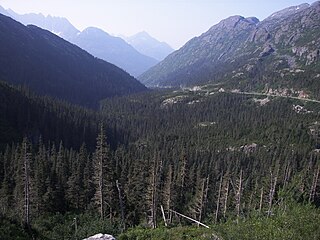
White Pass, also known as the Dead Horse Trail, is a mountain pass through the Boundary Ranges of the Coast Mountains on the border of the U.S. state of Alaska and the province of British Columbia, Canada. It leads from Skagway, Alaska, to the chain of lakes at the headwaters of the Yukon River, Crater Lake, Lake Lindeman, and Bennett Lake.

Klondike Gold Rush National Historical Park is a national historical park operated by the National Park Service that seeks to commemorate the Klondike Gold Rush of the late 1890s. Though the gold fields that were the ultimate goal of the stampeders lay in the Yukon Territory, the park comprises staging areas for the trek there and the routes leading in its direction. There are four units, including three in Municipality of Skagway Borough, Alaska and a fourth in the Pioneer Square National Historic District in Seattle, Washington.

Keish, also known as James Mason and by the nickname Skookum Jim Mason, was a member of the Tagish First Nation in what became the Yukon Territory of Canada. He was born near Bennett Lake on what is now the British Columbia and Yukon border. He lived in Caribou Crossing, now Carcross, Yukon, Canada.

The Chilkoot Trail tramways were aerial tramways that played a significant role in the Klondike Gold Rush and the Chilkoot Trail as a transportation system to move prospectors and equipment towards the Dawson City/Klondike gold fields.

The Yukon Trail is a 1994 educational computer game from the Minnesota Educational Computing Consortium (MECC), similar to their previous Oregon Trail series but set during the Klondike Gold Rush of the late 19th century. Players start out in Seattle and must make decisions concerning supplies, a partner, and travel plans as they head to Alaska before boating down a river to Dawson City and staking a claim to mine for gold. The game features the famous author Jack London and authentic 19th-century photographs that show what life was like back then.
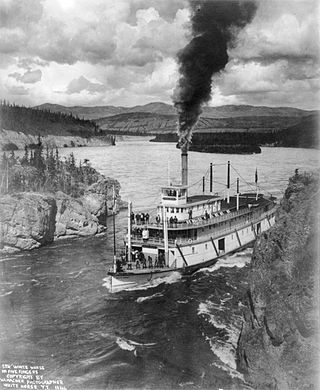
Steamboats on the Yukon River played a role in the development of Alaska and Yukon. Access to the interior of Alaska and Yukon was hindered by large mountains and distance, but the wide Yukon River provided a feasible route. The first steamers on the lower Yukon River were work boats for the Collins Overland Telegraph in 1866 or 1867, with a small steamer called Wilder. The mouth of the Yukon River is far to the west at St. Michael and a journey from Seattle or San Francisco covered some 4,000 miles (6,400 km).

Lindeman Lake, also known as Lake Lindeman, is a lake on the Chilkoot Trail in far northwestern British Columbia, Canada. It is just south of Bennett Lake and northeast of the summit of the Chilkoot Pass. From the direction of the pass it is fed by Lindeman Creek, which connects the two lakes. Lake Lindeman and Lake Bennett were key components of the Chilkoot Trail during the Klondike Gold Rush, with both seeing hundreds of vessels built to transit their waters and camp-town "tent cities" established on their shores. Lindeman was located at the south end of Lindeman Lake, while Bennett, often known as Bennett City, was at the south end of Lake Bennett.
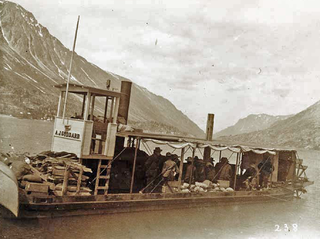
A. J. Goddard was a Klondike Gold Rush era sternwheeler owned by Seattle businessman Albert J. Goddard and built for transport of men and supplies on the Upper Yukon River in Canada. She was assembled from pieces which were manufactured in San Francisco, shipped up to Skagway, Alaska, hauled over the Coast Mountains, and finally assembled at Lake Bennett. She made one trip to Dawson during the gold rush, was sold and sank in a storm on Lake Laberge in 1901. Her wreck was discovered in 2008 by Doug Davidge and was designated as a Yukon Historic Site.
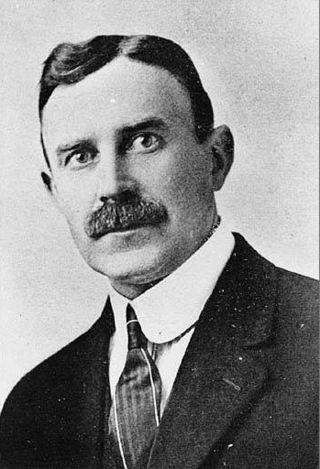
Eric A. Hegg was a Swedish-American photographer who portrayed the people in Skagway, Bennett and Dawson City during the Klondike Gold Rush from 1897 to 1901. Hegg himself participated in prospecting expeditions with his brother and fellow Swedes while documenting the daily life and hardships of the gold diggers.
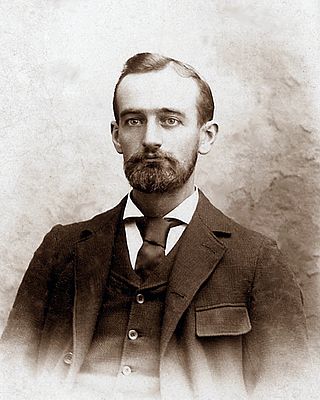
Frederick Trump was a German-born American barber and businessman. He was the patriarch of the Trump family and the paternal grandfather of Donald Trump, the 45th President of the United States.
The Klondike Trail or Chalmers Trail was an overland route to the Klondike Gold Rush in the Yukon, Canada. Prospectors were reaching the Klondike via the American route over the Chilkoot Pass, and the northern route via Edmonton and the Athabasca River. Edmonton's merchants, however, promoted an overland route, which appeared shorter on the map, but proved to be arduous, treacherous, and took much longer to travel.
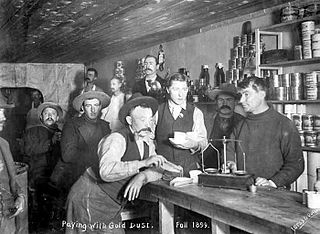
Larss and Duclos was a photographic studio partnership between Per Edvard Larss and Joseph E. N. Duclos (1863-1917) in Dawson City, Yukon Territory during the Klondike Gold Rush era of the late 19th and early 20th centuries.
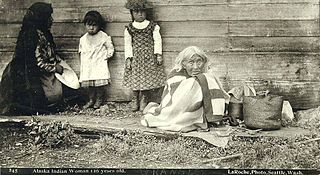
Frank La Roche was an American photographer who captured scenes of the Klondike gold rush and Chilkoot trail as well as Seattle, Washington where he had a studio. He published a book of photographs with descriptions En Route to the Klondike in 1898.

























